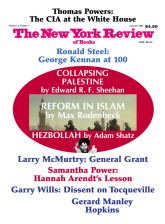To the Editors:
Steven Weinberg asserts that not “a single European battle in the Middle Ages” took place “that was won by a charge of cav-alry with couched lances against a line of foot soldiers” [“What Price Glory?” NYR, November 6, 2003]. He may be right about no such battle taking place in the Middle Ages, but there was one major European battle in which a cavalry charge with couched lance won the day. I am referring to the Battle of Vienna in September 1683. The Polish heavy cavalry, the hussaria, under King Sobieski, broke the Turkish line on the army’s right wing and in the center, and caused the entire army to flee in panic. From what I know, the massive Turkish army was made up largely of janissaries, who fought on foot. (Cavalry would not have been of much use in the siege of Vienna.)
Hussaria should not be confused with the huzars, the light cavalry used in the eighteenth and nineteenth centuries by European armies. Hussaria was the cream of the Polish army and mainly, though not exclusively, nobility served in its ranks and files. Once in service, soldiers were paid, but they were responsible for equipping themselves and their squires at considerable cost.
The hussaria’s main task was breaching enemy formations with charges at top speed. When the first charge was not successful, hussaria withdrew and charged again. There were battles in which the same troops charged ten times and later helped pursue the enemy. This was possible only with highly trained units that could withdraw and regroup in an orderly manner.
A hussar’s main weapon was a heavy lance of up to twenty feet in length, which outreached infantry pikes, allowing the hussaria to cut straight through an infantry square. It was supposed to break during the clash. After the lances were gone, sabers and estocs, a straight rapier-like weapon with a sixty- to seventy-inch-long blade which doubled as a pike and was used from horseback only, and pistols were used. Long firearms were recommended, but not required until the late seventeenth century. Many soldiers had bows, which (especially Tatar or Turkish bows) still had better range and were easier to use than early firearms.
Mr. Weinberg could argue that Sobieski was a much better commander than his Turkish opponent, Kara Mustafa, whose military incompetence apparently facilitated the relief of Vienna, and who was ordered to commit suicide by the sultan. Nor did the hussaria alone win the remaining part of the battle. The relief army consisted of many thousand Polish and German infantrymen, and light Tatar cavalry. But it was commonly agreed by the victors that the decisive moment in the battle was the hussaria charge.
Whether the Polish effort was worthwhile is another question. Barely one hundred years later, the now powerful Austro-Hungarian Empire assisted Russia and an ascendant Prussia in the partition of Poland.
Harry Lieber
Vancouver, British Columbia
Steven Weinberg replies:
Mr. Lieber’s letter is extremely interesting. I had not known that in the 1683 Battle of Vienna, Jan Sobieski’s cavalry charge against the Turkish infantry was with couched lances. I had argued in my article for the ineffectiveness of this tactic in medieval warfare, but this episode serves as a reminder of one way that a cavalry charge with or without couched lance might win a battle—by terrifying ill-prepared foot soldiers out of their wits rather than by doing them any actual harm. That seems to have been what happened at Vienna. The Turkish infantry had been thrown into confusion by an effective charge by Marigny’s infantry just before the charge by Sobieski’s cavalry. The cavalry, rushing toward them with couched lances, threw the disorganized Turkish infantry into a panic from which they could not be rallied. Similar episodes may have occurred in the Middle Ages. On the other hand, the cavalry charge with couched lance was quite ineffective against well-prepared infantry, like the English archers of the Hundred Years’ War.
This Issue
April 29, 2004



